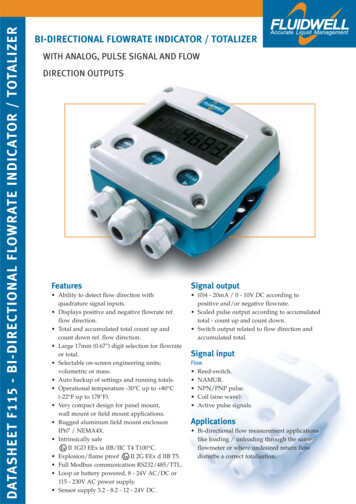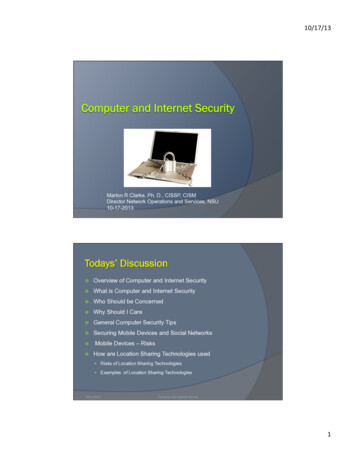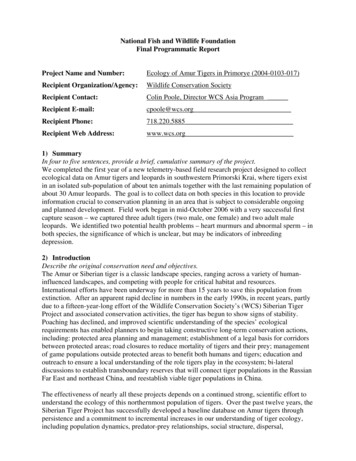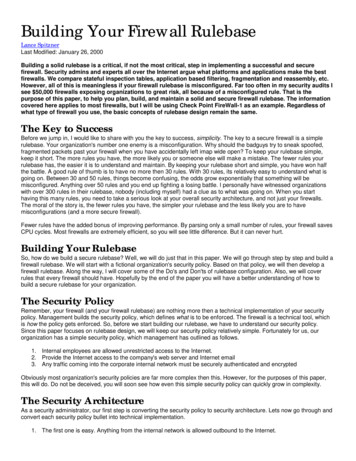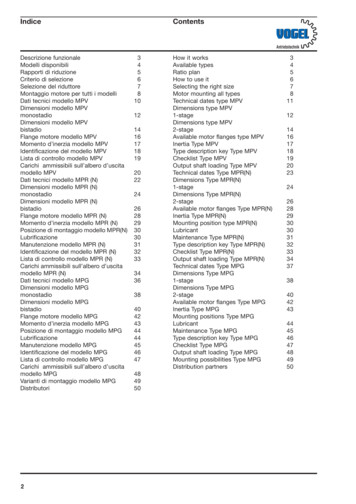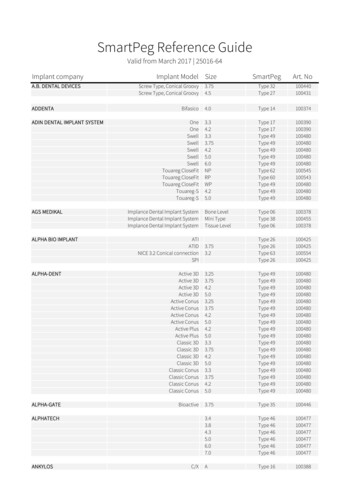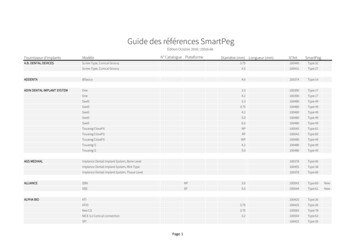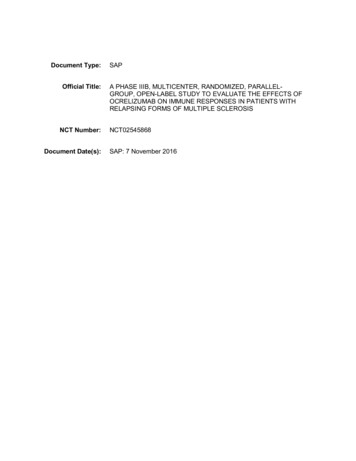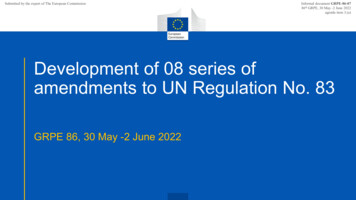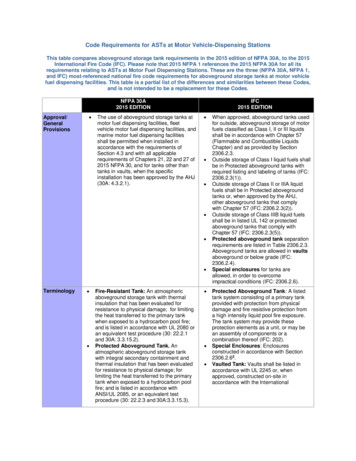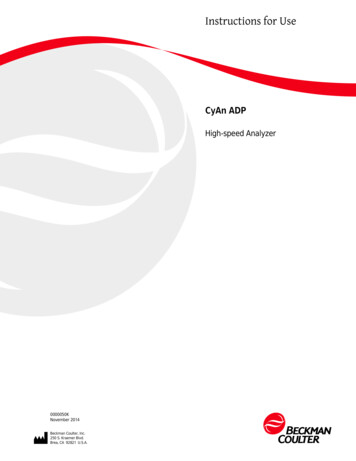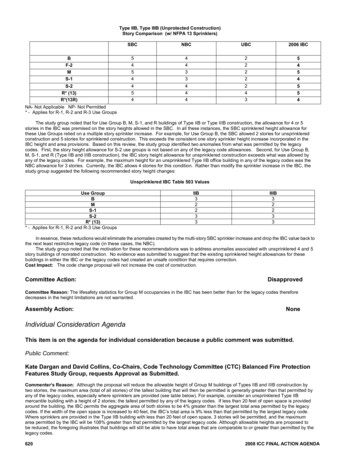
Transcription
Type IIB, Type IIIB (Unprotected Construction)Story Comparison (w/ NFPA 13 Sprinklers)SBCNBCUBC2006 IBCBF-2MS-15454443322225454S-2R* (13)R*(13R)454444243554NA- Not Applicable NP- Not Permitted* - Applies for R-1, R-2 and R-3 Use GroupsThe study group noted that for Use Group B, M, S-1, and R buildings of Type IIB or Type IIIB construction, the allowance for 4 or 5stories in the IBC was premised on the story heights allowed in the SBC. In all these instances, the SBC sprinklered height allowance forthese Use Groups relied on a multiple story sprinkler increase. For example, for Use Group B, the SBC allowed 2 stories for unsprinkleredconstruction and 5 stories for sprinklered construction. This exceeds the consistent one story sprinkler height increase incorporated in theIBC height and area provisions. Based on this review, the study group identified two anomalies from what was permitted by the legacycodes. First, the story height allowance for S-2 use groups is not based on any of the legacy code allowances. Second, for Use Group B,M, S-1, and R (Type IIB and IIIB construction), the IBC story height allowance for unsprinklered construction exceeds what was allowed byany of the legacy codes. For example, the maximum height for an unsprinklered Type IIB office building in any of the legacy codes was theNBC allowance for 3 stories. Currently, the IBC allows 4 stories for this condition. Rather than modify the sprinkler increase in the IBC, thestudy group suggested the following recommended story height changes:Unsprinklered IBC Table 503 ValuesUse GroupBMS-1S-2R* (13)* - Applies for R-1, R-2 and R-3 Use GroupsIIB32233IIIB32233In essence, these reductions would eliminate the anomalies created by the multi-story SBC sprinkler increase and drop the IBC value back tothe next least restrictive legacy code (in these cases, the NBC).The study group noted that the motivation for these recommendations was to address anomalies associated with unsprinklered 4 and 5story buildings of nonrated construction. No evidence was submitted to suggest that the existing sprinklered height allowances for thesebuildings in either the IBC or the legacy codes had created an unsafe condition that requires correction.Cost Impact: The code change proposal will not increase the cost of construction.Committee Action:DisapprovedCommittee Reason: The lifesafety statistics for Group M occupancies in the IBC has been better than for the legacy codes thereforedecreases in the height limitations are not warranted.Assembly Action:NoneIndividual Consideration AgendaThis item is on the agenda for individual consideration because a public comment was submitted.Public Comment:Kate Dargan and David Collins, Co-Chairs, Code Technology Committee (CTC) Balanced Fire ProtectionFeatures Study Group, requests Approval as Submitted.Commenter s Reason: Although the proposal will reduce the allowable height of Group M buildings of Types IIB and IIIB construction bytwo stories, the maximum area (total of all stories) of the tallest building that will then be permitted is generally greater than that permitted byany of the legacy codes, especially where sprinklers are provided (see table below). For example, consider an unsprinklered Type IIBmercantile building with a height of 2 stories; the tallest permitted by any of the legacy codes. If less than 20 feet of open space is providedaround the building, the IBC permits the aggregate area of both stories to be 4% greater than the largest total area permitted by the legacycodes. If the width of the open space is increased to 40 feet, the IBC’s total area is 9% less than that permitted by the largest legacy code.Where sprinklers are provided in the Type IIB building with less than 20 feet of open space, 3 stories will be permitted, and the maximumarea permitted by the IBC will be 108% greater than that permitted by the largest legacy code. Although allowable heights are proposed tobe reduced, the foregoing illustrates that buildings will still be able to have total areas that are comparable to or greater than permitted by thelegacy codes.6202008 ICC FINAL ACTION AGENDA
Ratio of IBC Maximum Building Area to the Largest MaximumWidth ofBuilding Area Permitted by Legacy CodesOpenSpaceNumber of Storiesa, b(ft.)12345 201.041.04NPLCNPLCNPNoNPLCNPLCNP400.910.91IIB 201.391.302.081.561.25Yes400.820.981.481.301.04M 201.041.04NPLCNPLCNPNoNPLCNPLCNP400.910.91IIIB C means not permitted by any of the legacy codes, but permitted by IBC.NP means not permitted by any of the legacy codes or IBC.If G117 is approved, building heights represented by shaded cells will not be permitted by the IBC.a. Width of open space around 100% of building perimeter.b. 40 feet was used because the UBC required a minimum of 40 feet of open space on all sides in order to qualify for 100% area increase;the maximum permitted by that code. The NBC and SBC permitted maximum open space increases of 150% and 100%, respectively,at 30 feet.Code issues are assigned to the CTC by the ICC Board as “areas of study”. Information on the CTC, including: meeting agendas; minutes;reports; resource documents; presentations; and all other materials developed in conjunction with the CTC effort can be downloaded from thefollowing website: http://www.iccsafe.org/cs/cc/ctc/index.html. This public comment is a result of the CTC’s investigation of the area of studyentitled “Balanced Fire Protection”. The CTC web page for this area of study is: http://www.iccsafe.org/cs/cc/ctc/WTC.html. As part of the CTCprocess, Study Groups are often formed to address specific issues related to CTC areas of study. The CTC BFP Features Study group is onesuch study group. This study group was formed subsequent to the 2006 Orlando Code Development Hearings, with the focus being a review ofthe height and area provisions in the IBC. Since its inception, the study group has held ten meetings - all open to the public.OccupancyGroupType ofConstructionFinal Action:ASNFPA 13Sprinklers –Yes/NoAMAMPCDG118-07/08Table 503Proposed Change as Submitted:Proponent: Kate Dargan and David Collins, Co-Chairs, Code Technology Committee (CTC) Balanced FireProtection Features Study GroupRevise table as follows:TABLE 503ALLOWABLE HEIGHT AND BUILDING AREASaHeight limitations shown as stories and feet above grade plane.Area limitations as determined by the definition of “Area, building,” per storyTYPE OF CONSTRUCTIONTYPE ITYPE IITYPE IIITYPE IVTYPE 4R-1AULUL24,000 16,000 24,000S4UL1144 3R-2AULUL24,000 16,000 24,000S4UL1144 3R-4AULUL24,000 16,000 24,000(Portions of table and footnotes not shown remain unchanged)554 316,00065420,50050312,0004027,0004 316,000420,500312,00027,0004 316,000420,500312,00027,000Reason: One area of concern identified for study by the Height and Area Task Group was 4 and 5 story buildings of unrated construction.The table below shows the occupancies in the IBC where that condition exists for sprinklered construction. In addition, the table shows thesprinklered height allowances for these occupancies in the legacy codes.2008 ICC FINAL ACTION AGENDA621
Type IIB, Type IIIB (Unprotected Construction)Story Comparison (w/ NFPA 13 Sprinklers)BF-2MS-1S-2R* (13)R*(13R)NA- Not Applicable NP- Not Permitted* - Applies for R-1, R-2 and R-3 Use GroupsSBC5454454NBC4433444UBC22222432006 IBC5454554The study group noted that for Use Group B, M, S-1, and R buildings of Type IIB or Type IIIB construction, the allowance for 4 or 5stories in the IBC was premised on the story heights allowed in the SBC. In all these instances, the SBC sprinklered height allowance forthese Use Groups relied on a multiple story sprinkler increase. For example, for Use Group B, the SBC allowed 2 stories for unsprinkleredconstruction and 5 stories for sprinklered construction. This exceeds the consistent one story sprinkler height increase incorporated in theIBC height and area provisions. Based on this review, the study group identified two anomalies from what was permitted by the legacycodes. First, the story height allowance for S-2 use groups is not based on any of the legacy code allowances. Second, for Use Group B,M, S-1, and R (Type IIB and IIIB construction), the IBC story height allowance for unsprinklered construction exceeds what was allowed byany of the legacy codes. For example, the maximum height for an unsprinklered Type IIB office building in any of the legacy codes was theNBC allowance for 3 stories. Currently, the IBC allows 4 stories for this condition. Rather than modify the sprinkler increase in the IBC, thestudy group suggested the following recommended story height changes:Use GroupBMS-1S-2R* (13)* - Applies for R-1, R-2 and R-3 Use GroupsUnsprinklered IBC Table 503 ValuesIIB32233IIIB32233In essence, these reductions would eliminate the anomalies created by the multi-story SBC sprinkler increase and drop the IBC value back tothe next least restrictive legacy code (in these cases, the NBC).The study group noted that the motivation for these recommendations was to address anomalies associated with unsprinklered 4 and 5story buildings of nonrated construction. No evidence was submitted to suggest that the existing sprinklered height allowances for thesebuildings in either the IBC or the legacy codes had created an unsafe condition that requires correction.Cost Impact: The code change proposal will increase the cost of construction.Committee Action:DisapprovedCommittee Reason: All Group R occupancies are now required to be protected by sprinklers in the IBC, therefore, this revision isinappropriate. When this table was originally constructed such occupancies were not required to be sprinklered.Assembly Action:NoneIndividual Consideration AgendaThis item is on the agenda for individual consideration because a public comment was submitted.Public Comment:Kate Dargan and David Collins, Co-Chairs, Code Technology Committee (CTC) Balanced Fire ProtectionFeatures Study Group, request Approval as Submitted.Commenter s Reason: Although the proposal will reduce the allowable height of Group R buildings of Types IIB and IIIB construction byone story, the maximum area (total of all stories) of the tallest building that will then be permitted is generally considerably greater than thatpermitted by any of the legacy codes (see table below). For example, consider a building which does not have an NFPA 13 sprinkler systemof Type IIB residential building with a height of 3 stories; the tallest permitted by any of the legacy codes. If less than 20 feet of open spaceis provided around the building, the IBC permits the aggregate area of all three stories to be 108% greater than the largest total areapermitted by the legacy codes. If the width of the open space is increased to 40 feet, the IBC’s total area is still 27% greater than thatpermitted by the largest legacy code. If NFPA 13 sprinklers are provided in a building of Type IIB construction, the height of the building canbe increased to four stories. If the building has less than 20 feet of open space, the maximum area permitted by the IBC is 50% greater thanthat permitted by the largest legacy code. Although allowable heights are proposed to be reduced, the foregoing illustrates that buildings willstill be able to have total areas that are comparable to or greater than that permitted by the largest legacy code. This proposal has no impacton residential buildings equipped with NFPA 13R or NFPA 13D sprinklers.6222008 ICC FINAL ACTION AGENDA
Ratio of IBC Maximum Building Area to the Largest MaximumWidth ofBuilding Area Permitted by Legacy CodesOpenSpaceNumber of Storiesa, b(ft.)12345 201.331.332.08NPLCNPNoNPLCNP401.171.171.27IIB R-2 201.331.332.08NPLCNPR-4NoNPLCNP401.171.171.27IIIB C means not permitted by any of the legacy codes, but permitted by IBC.NP means not permitted by any of the legacy codes or IBC.If G118 is approved, building heights represented by shaded cells will not be permitted by the IBC.a. Width of open space around 100% of building perimeter.b. 40 feet was used because the UBC required a minimum of 40 feet of open space on all sides in order to qualify for 100% area increase;the maximum permitted by that code. The NBC and SBC permitted maximum open space increases of 150% and 100%, respectively, at 30feet.OccupancyGroupType ofConstructionNFPA 13Sprinklers –Yes/NoCode issues are assigned to the CTC by the ICC Board as “areas of study”. Information on the CTC, including: meeting agendas;minutes; reports; resource documents; presentations; and all other materials developed in conjunction with the CTC effort can bedownloaded from the following website: http://www.iccsafe.org/cs/cc/ctc/index.html. This public comment is a result of the CTC’sinvestigation of the area of study entitled “Balanced Fire Protection”. The CTC web page for this area of study is:http://www.iccsafe.org/cs/cc/ctc/WTC.html. As part of the CTC process, Study Groups are often formed to address specific issues related toCTC areas of study. The CTC BFP Features Study group is one such study group. This study group was formed subsequent to the 2006Orlando Code Development Hearings, with the focus being a review of the height and area provisions in the IBC. Since its inception, thestudy group has held ten meetings - all open to the public.Final Action:ASAMAMPCDG119-07/08Table 503Proposed Change as Submitted:Proponent: Kate Dargan and David Collins, Co-Chairs, Code Technology Committee (CTC) Balanced FireProtection Features Study GroupRevise table as follows:TABLE 503ALLOWABLE HEIGHT AND BUILDING AREASaHeight limitations shown as stories and feet above grade plane.Area limitations as determined by the definition of “Area, building,” per storyTYPE OF CONSTRUCTIONTYPE ITYPE IITYPE IIITYPE IVTYPE VABABABHTABHGT(feet)GROUPHGT(S)UL160655565S3 23UL114S-1AUL48,000 26,000 17,500 26,000(Portions of table and footnotes not shown remain unchanged)553 217,50065425,50050314,0004019,000Reason: One area of concern identified for study by the Height and Area Task Group was 4 and 5 story buildings of unrated construction. Thetable below shows the occupancies in the IBC where that condition exists for sprinklered construction. In addition, the table shows the sprinkleredheight allowances for these occupancies in the legacy codes.2008 ICC FINAL ACTION AGENDA623
Type IIB, Type IIIB (Unprotected Construction)Story Comparison (w/ NFPA 13 Sprinklers)BF-2MS-1S-2R* (13)R*(13R)SBC5454454NBC4433444UBC22222432006 IBC5454554NA- Not Applicable NP- Not Permitted* - Applies for R-1, R-2 and R-3 Use GroupsThe study group noted that for Use Group B, M, S-1, and R buildings of Type IIB or Type IIIB construction, the allowance for 4 or 5stories in the IBC was premised on the story heights allowed in the SBC. In all these instances, the SBC sprinklered height allowance forthese Use Groups relied on a multiple story sprinkler increase. For example, for Use Group B, the SBC allowed 2 stories for unsprinkleredconstruction and 5 stories for sprinklered construction. This exceeds the consistent one story sprinkler height increase incorporated in theIBC height and area provisions. Based on this review, the study group identified two anomalies from what was permitted by the legacycodes. First, the story height allowance for S-2 use groups is not based on any of the legacy code allowances. Second, for Use Group B,M, S-1, and R (Type IIB and IIIB construction), the IBC story height allowance for unsprinklered construction exceeds what was allowed byany of the legacy codes. For example, the maximum height for an unsprinklered Type IIB office building in any of the legacy codes was theNBC allowance for 3 stories. Currently, the IBC allows 4 stories for this condition. Rather than modify the sprinkler increase in the IBC, thestudy group suggested the following recommended story height changes:Use GroupBMS-1S-2R* (13)* - Applies for R-1, R-2 and R-3 Use GroupsUnsprinklered IBC Table 503 ValuesIIB32233IIIB32233In essence, these reductions would eliminate the anomalies created by the multi-story SBC sprinkler increase and drop the IBC valueback to the next least restrictive legacy code (in these cases, the NBC).The study group noted that the motivation for these recommendations was to address anomalies associated with unsprinklered 4 and 5story buildings of nonrated construction. No evidence was submitted to suggest that the existing sprinklered height allowances for thesebuildings in either the IBC or the legacy codes had created an unsafe condition that requires correction.Cost Impact: The code change proposal will increase the cost of construction.Committee Action:DisapprovedCommittee Reason: Justification to reduce or revise height and area limitations for buildings based upon the legacy code requirements isnot sufficient.Assembly Action:NoneIndividual Consideration AgendaThis item is on the agenda for individual consideration because a public comment was submitted.Public Comment:Kate Dargan and David Collins, Co-Chairs, Code Technology Committee (CTC) Balanced Fire ProtectionFeatures Study Group, request Approval as Submitted.Commenter s Reason: Although the proposal will reduce the allowable height of Group S-1 buildings of Types IIB and IIIB construction byone story, the maximum area (total of all stories) of the tallest building that will then be permitted is generally greater than that permitted byany of the legacy codes, especially where sprinklers are provided (see table below). For example, consider an unsprinklered Type IIB S-1storage building with a height of 2 stories; the tallest permitted by any of the legacy codes. If less than 20 feet of open space is providedaround the building, the IBC permits the aggregate area of both stories to be 9% greater than the largest total area permitted by the legacycodes. If the width of the open space is increased to 40 feet, the IBC’s total area is 4% less than that permitted by the largest legacy code.Where sprinklers are provided in the Type IIB building with less than 20 feet of open space, 3 stories will be permitted, and the maximumarea permitted by the IBC will be 64% greater than that permitted by the largest legacy code. Although allowable heights are proposed to bereduced, the foregoing illustrates that buildings will still be able to have total areas that are comparable to or greater than permitted by thelegacy codes.6242008 ICC FINAL ACTION AGENDA
Ratio of IBC Maximum Building Area to the Largest MaximumWidth ofBuilding Area Permitted by Legacy CodesOpenSpaceNumber of Storiesa, b(ft.)1234 201.091.09NPLCNPNoNPLCNP400.960.96IIB 201.461.641.641.23Yes401.151.371.371.03S-1 201.091.09NPLCNPNoNPLCNP400.960.96IIIB 201.461.641.641.23Yes1.03401.151.371.37NPLC means not permitted by any of the legacy codes, but permitted by IBC.NP means not permitted by any of the legacy codes or IBC.If G119 is approved, building heights represented by shaded cells will not be permitted by the IBC.a. Width of open space around 100% of building perimeter.b. 40 feet was used because the UBC required a minimum of 40 feet of open space on all sides in order to qualify for 100% area increase;the maximum permitted by that code. The NBC and SBC permitted maximum open space increases of 150% and 100%, respectively, at 30feet.OccupancyGroupNFPA 13Sprinklers –Yes/NoType ofConstructionCode issues are assigned to the CTC by the ICC Board as “areas of study”. Information on the CTC, including: meeting agendas; minutes;reports; resource documents; presentations; and all other materials developed in conjunction with the CTC effort can be downloaded from thefollowing website: http://www.iccsafe.org/cs/cc/ctc/index.html. This public comment is a result of the CTC’s investigation of the area of studyentitled “Balanced Fire Protection”. The CTC web page for this area of study is: http://www.iccsafe.org/cs/cc/ctc/WTC.html. As part of the CTCprocess, Study Groups are often formed to address specific issues related to CTC areas of study. The CTC BFP Features Study group is onesuch study group. This study group was formed subsequent to the 2006 Orlando Code Development Hearings, with the focus being a review ofthe height and area provisions in the IBC. Since its inception, the study group has held ten meetings - all open to the public.Final Action:ASAMAMPCDG120-07/08Table 503Proposed Change as Submitted:Proponent: Kate Dargan and David Collins, Co-Chairs, Code Technology Committee (CTC) Balanced FireProtection Features Study GroupRevise table as follows:TABLE 503ALLOWABLE HEIGHT AND BUILDING AREASaHeight limitations shown as stories and feet above grade plane.Area limitations as determined by the definition of “Area, building,” per storyTYPE OF CONSTRUCTIONTYPE ITYPE IITYPE IIITYPE IVTYPE VABABABHTABHGT(feet)GROUPb, cS-2HGT(S)SAULULUL1601179,00065539,000554 326,00065439,000554 326,00065538,50050421,00040213,500(Portions of table and footnotes not shown remain unchanged)Reason: One area of concern identified for study by the Height and Area Task Group was 4 and 5 story buildings of unrated construction. Thetable below shows the occupancies in the IBC where that condition exists for sprinklered construction. In addition, the table shows the sprinkleredheight allowances for these occupancies in the legacy codes.2008 ICC FINAL ACTION AGENDA625
Type IIB, Type IIIB (Unprotected Construction)Story Comparison (w/ NFPA 13 Sprinklers)BF-2MS-1S-2R* (13)R*(13R)SBC5454454NBC4433444UBC22222432006 IBC5454554NA- Not Applicable NP- Not Permitted* - Applies for R-1, R-2 and R-3 Use GroupsThe study group noted that for Use Group B, M, S-1, and R buildings of Type IIB or Type IIIB construction, the allowance for 4 or 5 stories inthe IBC was premised on the story heights allowed in the SBC. In all these instances, the SBC sprinklered height allowance for these UseGroups relied on a multiple story sprinkler increase. For example, for Use Group B, the SBC allowed 2 stories for unsprinklered constructionand 5 stories for sprinklered construction. This exceeds the consistent one story sprinkler height increase incorporated in the IBC height andarea provisions. Based on this review, the study group identified two anomalies from what was permitted by the legacy codes. First, thestory height allowance for S-2 use groups is not based on any of the legacy code allowances. Second, for Use Group B, M, S-1, and R(Type IIB and IIIB construction), the IBC story height allowance for unsprinklered construction exceeds what was allowed by any of thelegacy codes. For example, the maximum height for an unsprinklered Type IIB office building in any of the legacy codes was the NBCallowance for 3 stories. Currently, the IBC allows 4 stories for this condition. Rather than modify the sprinkler increase in the IBC, the studygroup suggested the following recommended story height changes:Use GroupBMS-1S-2R* (13)* - Applies for R-1, R-2 and R-3 Use GroupsUnsprinklered IBC Table 503 ValuesIIB32233IIIB32233In essence, these reductions would eliminate the anomalies created by the multi-story SBC sprinkler increase and drop the IBC value back tothe next least restrictive legacy code (in these cases, the NBC).The study group noted that the motivation for these recommendations was to address anomalies associated with unsprinklered 4 and 5story buildings of nonrated construction. No evidence was submitted to suggest that the existing sprinklered height allowances for thesebuildings in either the IBC or the legacy codes had created an unsafe condition that requires correction.Cost Impact: The code change proposal will increase the cost of construction.Committee Action:DisapprovedCommittee Reason: The proposal was disapproved based upon action on G119-07/08.Assembly Action:NoneIndividual Consideration AgendaThis item is on the agenda for individual consideration because a public comment was submitted.Public Comment:Kate Dargan and David Collins, Co-Chairs, Code Technology Committee (CTC) Balanced Fire ProtectionFeatures Study Group, request Approval as Submitted.Commenter s Reason: Although the proposal will reduce the allowable height of Group S-2 buildings of Types IIB and IIIB construction byone story, the maximum area (total of all stories) of the tallest building that will then be permitted is generally considerably greater than thatpermitted by any of the legacy codes, especially where sprinklers are provided (see table below). For example, consider an unsprinkleredType IIB S-2 storage building with a height of 3 stories; the tallest permitted by any of the legacy codes. If less than 20 feet of open space isprovided around the building, the IBC permits the aggregate area of all three stories to be 126% greater than the largest total area permittedby the legacy codes. If the width of the open space is increased to 40 feet, the IBC’s total area is 37% greater than that permitted by thelargest legacy code. Where sprinklers are provided in the Type IIB building with less than 20 feet of open space, 4 stories will be permitted,and the maximum area permitted by the IBC will be 83% greater than that permitted by the largest legacy code. Although allowable heightsare proposed to be reduced, the foregoing illustrates that buildings will still be able to have total areas that are comparable to or greater thanpermitted by the legacy codes.6262008 ICC FINAL ACTION AGENDA
Ratio of IBC Maximum Building Area to the Largest MaximumWidth ofBuilding Area Permitted by Legacy CodesOpenSpaceNumber of Storiesa, b(ft.)12345 201.441.442.26NPLCNPNoNPLCNP401.261.261.37IIB 201.931.812.441.83NPLCYes401.141.352.031.52NPLCS-2 201.441.442.26NPLCNPNoNPLCNP401.261.261.37IIIB C means not permitted by any of the legacy codes, but permitted by IBC.NP means not permitted by any of the legacy codes or IBC.If G120 is approved, building heights represented by shaded cells will not be permitted by the IBC.a. Width of open space around 100% of building perimeter.b. 40 feet was used because the UBC required a minimum of 40 feet of open space on all sides in order to qualify for 100% area increase;the maximum permitted by that code. The NBC and SBC permitted maximum open space increases of 150% and 100%, respectively,at 30 feet.OccupancyGroupType ofConstructionNFPA 13Sprinklers –Yes/NoCode issues are assigned to the CTC by the ICC Board as “areas of study”. Information on the CTC, including: meeting agendas;minutes; reports; resource documents; presentations; and all other materials developed in conjunction with the CTC effort can bedownloaded from the following website: http://www.iccsafe.org/cs/cc/ctc/index.html. This public comment is a result of the CTC’sinvestigation of the area of study entitled “Balanced Fire Protection”. The CTC web page for this area of study is:http://www.iccsafe.org/cs/cc/ctc/WTC.html. As part of the CTC process, Study Groups are often formed to address specific issues related toCTC areas of study. The CTC BFP Features Study group is one such study group. This study group was formed subsequent to the 2006Orlando Code Development Hearings, with the focus being a review of the height and area provisions in the IBC. Since its inception, thestudy group has held ten meetings - all open to the public.Final Action:ASAMAMPCDG123-07/08504.2Proposed Change as Submitted:Proponent: Rick Thornberry, PE, The Code Consortium, Inc., representing the Alliance for Fire and SmokeContainment and Control (AFSCC)1. Revise as follows:504.2 (Supp) Automatic sprinkler system increase. Where a building is equipped throughout with an approvedautomatic sprinkler system in accordance with Section 903.3.1.1, the value specified in Table 503 for maximumheight is shall be increased by 20 10 feet (6096 1524 mm), except that for Group B and H-4 occupancies inbuildings of Type IIA or IV construction, the increase shall be 20 feet, and the maximum number of stories is shallbe increased by one. These increases are shall be permitted in addition to the area increase in accordance withSections 506.2 and 506.3. For Group R buildings equipped throughout with an approved automatic sprinklersystem in accordance with Section 903.3.1.2, the value specified in Table 503 for maximum height is shall beincreased by 20 10 feet (6096 1524 mm) and the maximum number of stories is shall be increased by one, butshall not exceed 60 feet (18 288 mm) or four stories, respectively.Exceptions:1. Buildings, or portions of buildings, classified as a Group I-2 occupancy of Type IIB, III, IV or Vconstruction.2. Buildings, or portions of buildings, classified as a Group H-1, H-2, H-3 or H-5 occupancy.3. Fire-resistance rating substitution in accordance with Table 601, Note e.Reason: The purpose of this proposed code change is to reduce from 20 feet to 10 feet the height increase allowed when an automaticsprinkler system is installed throughout the building. This would apply not only to NFPA 13 sprinkler systems, but also to NFPA 13R sprinklersystems for Group R occupancies. During a thorough review of the heights allowed by the International Building Code (IBC) in comparison tothe three legacy codes, it was discovered that the 20 foot height increase for automatic sprinkler systems in the IBC allows taller buildingsthan any of the three legacy model building codes allowed with a few minor exceptions. Both the 1997 ICBO Uniform Building Code (UBC)and the 1999 SBCCI Standard Building Code (SBC) allowed the identical building heights for their comparable types of construction with theexception of IBC Type IB construction (UBC Type II – F.R. and SBC Type II) for which the UBC allowed the same height of 160 feet as theIBC as compared to 80 feet in the SBC. A maximum height of 120 feet was allowed in t
M, S-1, and R (Type IIB and IIIB construction), the IBC story height allowance for unsprinklered construction exceeds what was allowed by any of the legacy codes. For example, the maximum height for an unsprinklered Type IIB office building in any of the legacy codes was the NBC allowance for 3 stories.
